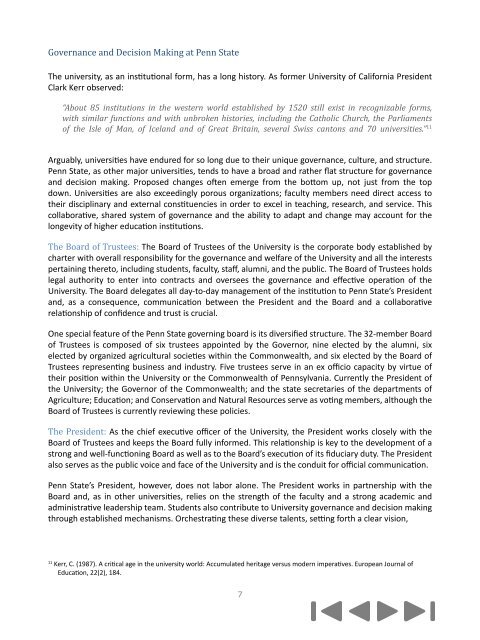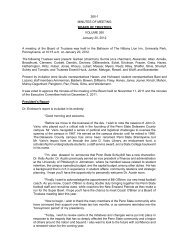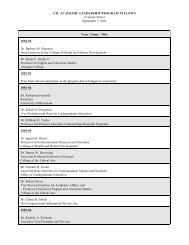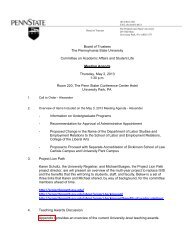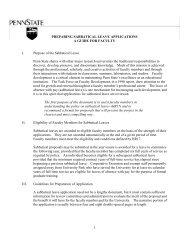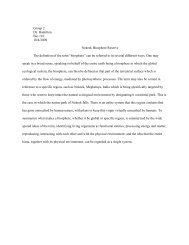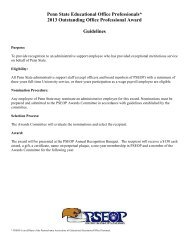A VISION FOR PENN STATE - Penn State University
A VISION FOR PENN STATE - Penn State University
A VISION FOR PENN STATE - Penn State University
You also want an ePaper? Increase the reach of your titles
YUMPU automatically turns print PDFs into web optimized ePapers that Google loves.
Governance and Decision Making at <strong>Penn</strong> <strong>State</strong><br />
The university, as an institutional form, has a long history. As former <strong>University</strong> of California President<br />
Clark Kerr observed:<br />
“About 85 institutions in the western world established by 1520 still exist in recognizable forms,<br />
with similar functions and with unbroken histories, including the Catholic Church, the Parliaments<br />
of the Isle of Man, of Iceland and of Great Britain, several Swiss cantons and 70 universities.” 11<br />
Arguably, universities have endured for so long due to their unique governance, culture, and structure.<br />
<strong>Penn</strong> <strong>State</strong>, as other major universities, tends to have a broad and rather flat structure for governance<br />
and decision making. Proposed changes often emerge from the bottom up, not just from the top<br />
down. Universities are also exceedingly porous organizations; faculty members need direct access to<br />
their disciplinary and external constituencies in order to excel in teaching, research, and service. This<br />
collaborative, shared system of governance and the ability to adapt and change may account for the<br />
longevity of higher education institutions.<br />
The Board of Trustees: The Board of Trustees of the <strong>University</strong> is the corporate body established by<br />
charter with overall responsibility for the governance and welfare of the <strong>University</strong> and all the interests<br />
pertaining thereto, including students, faculty, staff, alumni, and the public. The Board of Trustees holds<br />
legal authority to enter into contracts and oversees the governance and effective operation of the<br />
<strong>University</strong>. The Board delegates all day-to-day management of the institution to <strong>Penn</strong> <strong>State</strong>’s President<br />
and, as a consequence, communication between the President and the Board and a collaborative<br />
relationship of confidence and trust is crucial.<br />
One special feature of the <strong>Penn</strong> <strong>State</strong> governing board is its diversified structure. The 32-member Board<br />
of Trustees is composed of six trustees appointed by the Governor, nine elected by the alumni, six<br />
elected by organized agricultural societies within the Commonwealth, and six elected by the Board of<br />
Trustees representing business and industry. Five trustees serve in an ex officio capacity by virtue of<br />
their position within the <strong>University</strong> or the Commonwealth of <strong>Penn</strong>sylvania. Currently the President of<br />
the <strong>University</strong>; the Governor of the Commonwealth; and the state secretaries of the departments of<br />
Agriculture; Education; and Conservation and Natural Resources serve as voting members, although the<br />
Board of Trustees is currently reviewing these policies.<br />
The President: As the chief executive officer of the <strong>University</strong>, the President works closely with the<br />
Board of Trustees and keeps the Board fully informed. This relationship is key to the development of a<br />
strong and well-functioning Board as well as to the Board’s execution of its fiduciary duty. The President<br />
also serves as the public voice and face of the <strong>University</strong> and is the conduit for official communication.<br />
<strong>Penn</strong> <strong>State</strong>’s President, however, does not labor alone. The President works in partnership with the<br />
Board and, as in other universities, relies on the strength of the faculty and a strong academic and<br />
administrative leadership team. Students also contribute to <strong>University</strong> governance and decision making<br />
through established mechanisms. Orchestrating these diverse talents, setting forth a clear vision,<br />
11<br />
Kerr, C. (1987). A critical age in the university world: Accumulated heritage versus modern imperatives. European Journal of<br />
Education, 22(2), 184.<br />
7


